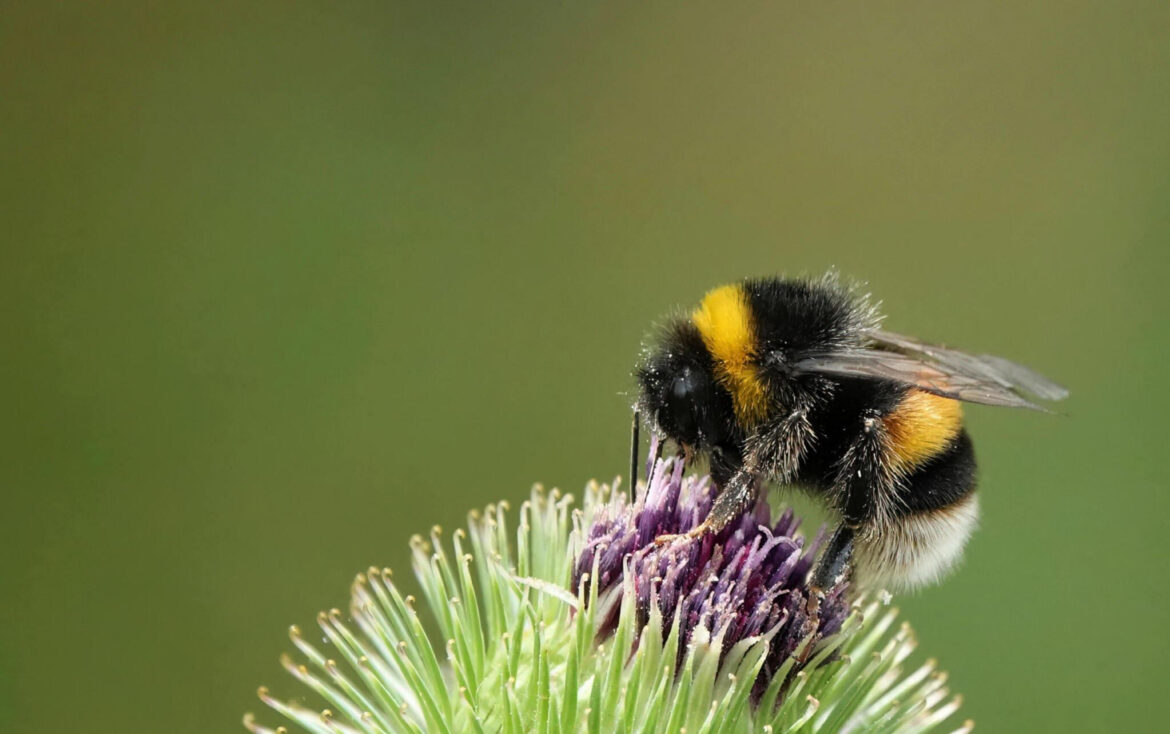Bumble bees are known for their fuzzy bodies and important role as pollinators. But what about their stingers? Do bumble bees sting? In this article, we will explore the truth behind bumble bee stings and provide valuable information about prevention, treatment, and the ecological role of these buzzing insects.
Key Takeaways:
- Bumble bees have the ability to sting, but they are not as aggressive as some other stinging insects.
- Bumble bee stings can cause pain, redness, swelling, itching, and in some cases, allergic reactions.
- To prevent bumble bee stings, it is important to avoid disturbing their nests and wear protective clothing.
- Treatment for bumble bee stings involves removing the stinger, cleaning the area, and using cold compresses and over-the-counter medications.
- Bumble bees play a crucial ecological role as pollinators, contributing to the reproduction of many plant species.
Understanding Bumble Bee Stings
When a bumble bee stings, it injects venom into the skin, which can cause pain, redness, swelling, and itching at the site of the sting. Some people may also experience an allergic reaction, which can include severe swelling, difficulty breathing, and hives.
Bumble bee stings can be painful and may result in localized symptoms that can last for several hours or even days. The severity of the symptoms can vary depending on the individual’s sensitivity to the venom and the number of stings received.
Here are some common symptoms of a bumble bee sting:
- Pain: The sting can cause immediate pain at the site of the sting.
- Redness: The area around the sting may become red and inflamed.
- Swelling: Swelling is a typical response to a bumble bee sting and can range from mild to severe.
- Itching: Itching at the site of the sting is common and can be persistent.
In rare cases, some individuals may experience an allergic reaction to a bumble bee sting. Symptoms of an allergic reaction can include:
- Severe swelling beyond the sting site, affecting a larger area of the body
- Difficulty breathing or wheezing
- Hives or a rash that spreads beyond the sting site
- Dizziness or lightheadedness
- Nausea or vomiting
If an allergic reaction is suspected, it is essential to seek medical attention immediately.
| Symptom | Severity | Treatment |
|---|---|---|
| Pain | Mild to moderate | Over-the-counter pain relievers such as acetaminophen or ibuprofen |
| Redness | Mild to moderate | Applying a cold compress and using topical anti-inflammatory creams |
| Swelling | Mild to severe | Elevating the affected area and applying cold compresses |
| Itching | Mild to moderate | Over-the-counter antihistamines or topical anti-itch creams |
| Allergic reaction | Severe | Immediate medical attention, including an epinephrine injection if prescribed |
Prevention and Treatment of Bumble Bee Stings
To prevent bumble bee stings, it is important to take precautions and be mindful of their habitats. Avoid disturbing their nests and wear protective clothing, such as long sleeves and pants, when in areas with bumble bee activity.
If unfortunately stung by a bumble bee, immediate treatment is crucial. Begin treatment by carefully removing the stinger from the skin using tweezers or a credit card. Avoid using your fingers as it may squeeze more venom into the wound.
Next, cleanse the affected area with mild soap and water to prevent infection. Applying a cold compress to the sting site can help reduce pain, redness, and swelling. Over-the-counter pain relievers like ibuprofen or acetaminophen can also provide relief.
For itching and discomfort, antihistamine creams or orally administered antihistamines can be effective. It is essential to follow the recommended dosage guidelines and seek medical advice if necessary.
In severe cases of bumble bee stings, where symptoms progress rapidly or an allergic reaction occurs, seeking immediate medical attention is crucial. A healthcare professional may prescribe epinephrine or other medications to treat anaphylaxis or severe allergic reactions.
Common Misconceptions about Bumble Bee Stings
There are some misconceptions about bumble bee stings that need to be clarified. One common belief is that bumble bees eat other insects, but this is actually incorrect. Bumble bees are primarily vegetarian and rely on a diet of nectar and pollen to survive. They are important pollinators for various plant species.
While bumble bees may engage in behaviors that involve insects, such as robbing other hives or cleaning their own hive, these actions are not related to eating insects. Instead, they are part of the natural hive maintenance and protection processes.
It is essential to understand the true nature of bumble bees and their dietary habits. By dispelling these misconceptions, we can appreciate the valuable role bumble bees play in our ecosystems and work towards their conservation.
Bumble Bee Sting Facts
| Fact | Description |
|---|---|
| Bumble bee stings | They have the ability to sting |
| Aggression | They are not as aggressive as some other stinging insects |
| Sting triggers | They typically only sting when their nest or themselves are threatened |
| Sting symptoms | Can cause pain, redness, swelling, and itching |
| Allergic reactions | Some people may experience severe swelling, difficulty breathing, and hives |
Do Bumble Bees Sting Other Insects?
Another misconception is whether bumble bees sting other insects. Bumble bees do not typically sting other insects as a means of defense or prey. Their focus is primarily on pollination and acquiring food from flowers. While they may interact with other insects during foraging, it is not related to stinging.
The table below provides a comparison between misconceptions and the facts regarding bumble bee stings:
| Misconception | Facts |
|---|---|
| Bumble bees eat other insects | Bumble bees are primarily vegetarian and feed on nectar and pollen |
| Bumble bees sting other insects | Bumble bees do not sting other insects as a defense mechanism or for prey |
By debunking these misconceptions, we can better understand bumble bees and their important role in our ecosystems. They are fascinating creatures that contribute to the pollination of plants and the overall balance of nature.
Natural Predators of Bumble Bees
Bumble bees, like any other living creatures, have their fair share of natural predators in the animal kingdom. These predators can target bumble bees for various reasons, including food and survival. From birds to mammals, insects to reptiles, a variety of animals have been known to prey on bumble bees.
Bird Predators
- Eurasian hoopoes
- Northern flickers
- Flycatchers
Mammal Predators
- Bears
- Skunks
- Badgers
- Voles
Insect Predators
- Dragonflies
- Robber flies
- Wasps
- Spiders
Reptile Predators
- Snakes
- Lizards
It’s important to note that these predators do not exclusively target bumble bees but may prey on them when the opportunity arises. The natural balance between bumble bees and their predators is essential for maintaining healthy ecosystems.
The Ecological Role of Bumble Bees
Bumble bees play a crucial role in ecosystems as important pollinators. Their unique physiology and behavior make them highly effective in the pollination process, ensuring the reproduction of many plant species, including essential crops and vibrant wildflowers.
As bumble bees forage for nectar and pollen, they inadvertently transfer pollen between flowers, resulting in fertilization and fruit or seed production. This process enables the plants to reproduce and maintain their populations, thus sustaining the biodiversity of ecosystems.
Without bumble bees as pollinators, the availability of food and the health of ecosystems would be severely jeopardized. Many fruits, vegetables, and nuts that humans rely on for nutrition and sustenance are reliant on bumble bees for successful pollination. Additionally, bumble bees contribute to the reproduction and survival of numerous flowering plants, which provide habitats and food sources for other wildlife.
The importance of bumble bees as pollinators extends beyond agricultural and ecological perspectives. They also support the preservation of genetic diversity within plant populations, which is vital for long-term resilience to environmental changes and challenges.
Overall, bumble bees play a critical role in maintaining the balanced functioning of ecosystems and the sustainability of life on Earth. As awareness of their importance grows, efforts to protect and conserve bumble bees and their habitats become increasingly necessary.
| Bumble Bee Pollination Facts | |
|---|---|
| Bumble bees are “buzz pollinators,” using sonic vibrations to release pollen from flowers that cling tightly to anthers. | |
| Bumble bees are capable of flying in cooler temperatures than many other pollinators, making them effective spring pollinators when flowers first bloom. | |
| A single bumble bee can visit hundreds of flowers each day, enhancing cross-pollination and genetic diversity. |
Human Interaction with Bumble Bees
When it comes to bumble bees, it is crucial for humans to interact with them responsibly and respectfully. This means avoiding the temptation to feed bumble bees directly. While it may seem like a kind gesture, feeding bumble bees can actually disrupt their natural foraging patterns and lead to dependence on human-provided food.
To protect bumble bees and their habitats, conservation efforts should focus on preserving natural habitats where they can find a diverse range of nectar and pollen sources. Additionally, reducing pesticide use is essential to minimize the negative impacts on bumble bee populations and their environments. By promoting awareness about the importance of bumble bees as pollinators, we can encourage others to join us in protecting these vital creatures.
Conclusion
In conclusion, while bumble bees do have the ability to sting, they are not aggressive insects. They typically only sting when their nest or themselves are threatened. Understanding this behavior and knowing how to prevent and treat bumble bee stings is essential to minimize their impact.
To prevent bumble bee stings, it is important to avoid disturbing their nests and wear protective clothing when in areas with bumble bee activity. If stung, immediate treatment should include removing the stinger, cleaning the area with soap and water, and applying a cold compress to reduce swelling. Over-the-counter pain relievers and antihistamines can help alleviate symptoms, and in severe cases, medical intervention may be necessary.
It is also crucial to recognize the ecological importance of bumble bees. As vital pollinators, they play a significant role in maintaining the biodiversity of ecosystems and ensuring the availability of food. Protecting their habitats, reducing pesticide use, and raising awareness about their importance are key to their conservation and the overall health of our environment. By understanding and respecting these amazing creatures, we can coexist harmoniously and support the vital work they do.
FAQ
Do bumble bees sting?
Yes, bumble bees do have the ability to sting. However, they are not as aggressive as some other stinging insects and typically only sting when their nest or themselves are threatened.
What are the symptoms of a bumble bee sting?
The symptoms of a bumble bee sting may include pain, redness, swelling, and itching at the site of the sting. Some people may also experience an allergic reaction, which can include severe swelling, difficulty breathing, and hives.
How can I prevent bumble bee stings?
To prevent bumble bee stings, it is important to avoid disturbing their nests and wear protective clothing when in areas with bumble bee activity.
What should I do if I get stung by a bumble bee?
If stung, immediate treatment should include removing the stinger, cleaning the area with soap and water, and applying a cold compress to reduce swelling. Over-the-counter pain relievers and antihistamines can help alleviate symptoms. In severe cases, a doctor may prescribe epinephrine or other medications.
Are there any misconceptions about bumble bee stings?
Yes, there are some misconceptions about bumble bee stings. One common misconception is that bumble bees eat other insects, but in reality, they are primarily vegetarian, feeding on nectar and pollen.
Do bumble bees have natural predators?
Yes, bumble bees have natural predators, including certain bird species, mammals like bears and skunks, insects like dragonflies and robber flies, and even some reptiles.
What is the ecological role of bumble bees?
Bumble bees play a crucial ecological role as pollinators. They are essential for the reproduction of many plant species, including crops and wildflowers.
How should humans interact with bumble bees?
It is important for humans to interact with bumble bees in a responsible and respectful way. Feeding bumble bees can disrupt their natural foraging patterns and lead to dependence on human-provided food. Conservation efforts should focus on preserving natural habitats, reducing pesticide use, and promoting awareness about the importance of these pollinators.
What is the conclusion about bumble bee stings?
Bumble bees do have the ability to sting, but they are not aggressive and typically only sting when threatened. Prevention and proper treatment can help minimize the impact of bumble bee stings. Understanding the ecological role of bumble bees and taking steps to protect their habitats is crucial for their conservation and the overall health of ecosystems.







